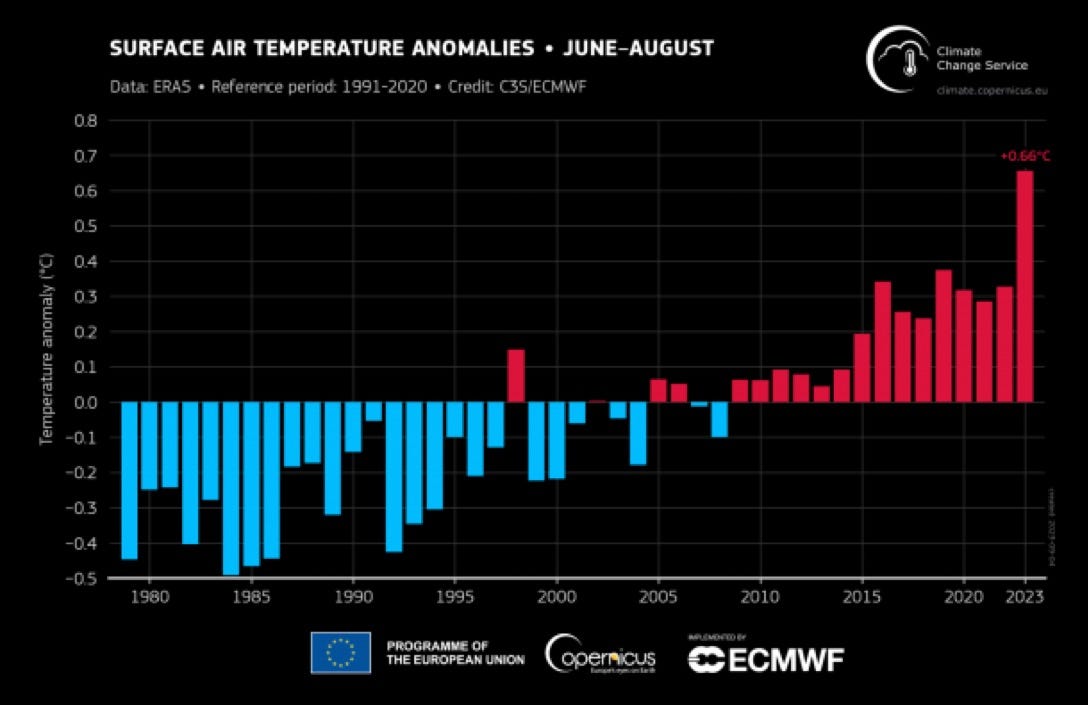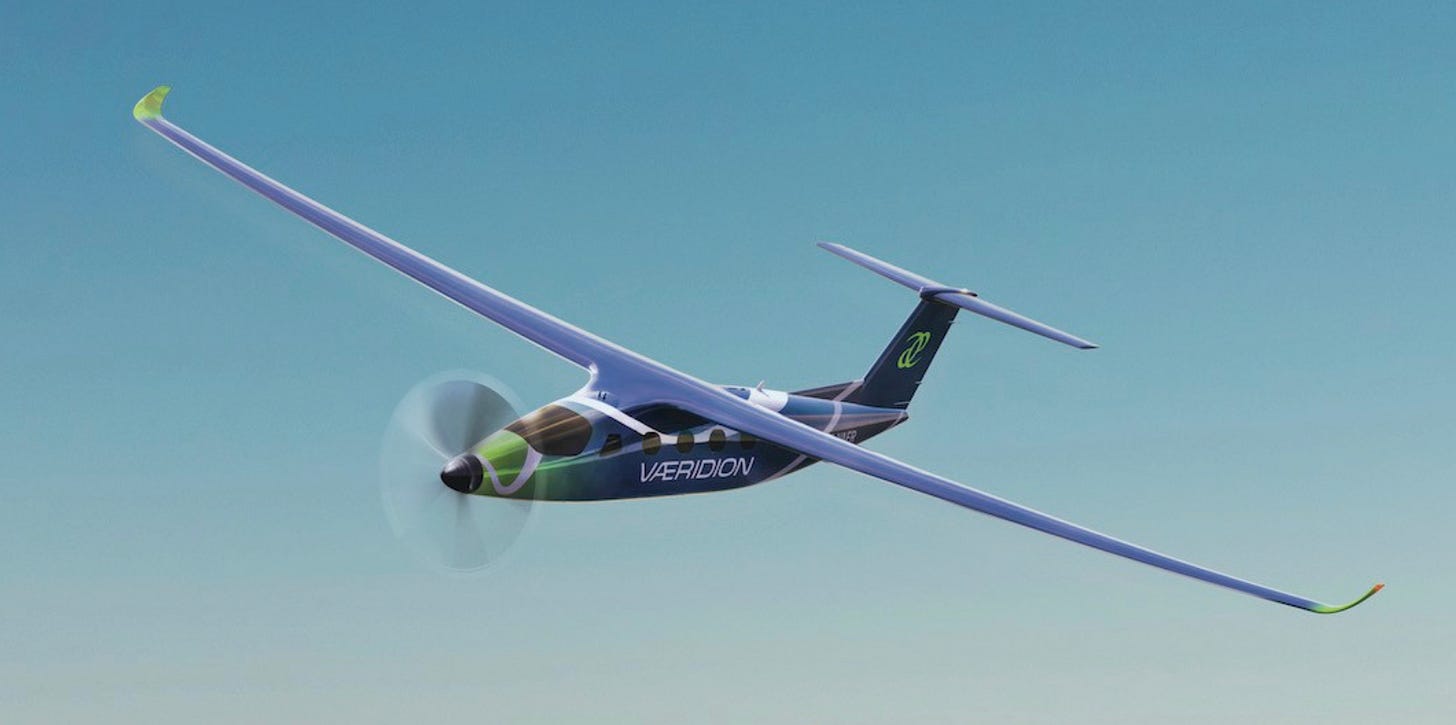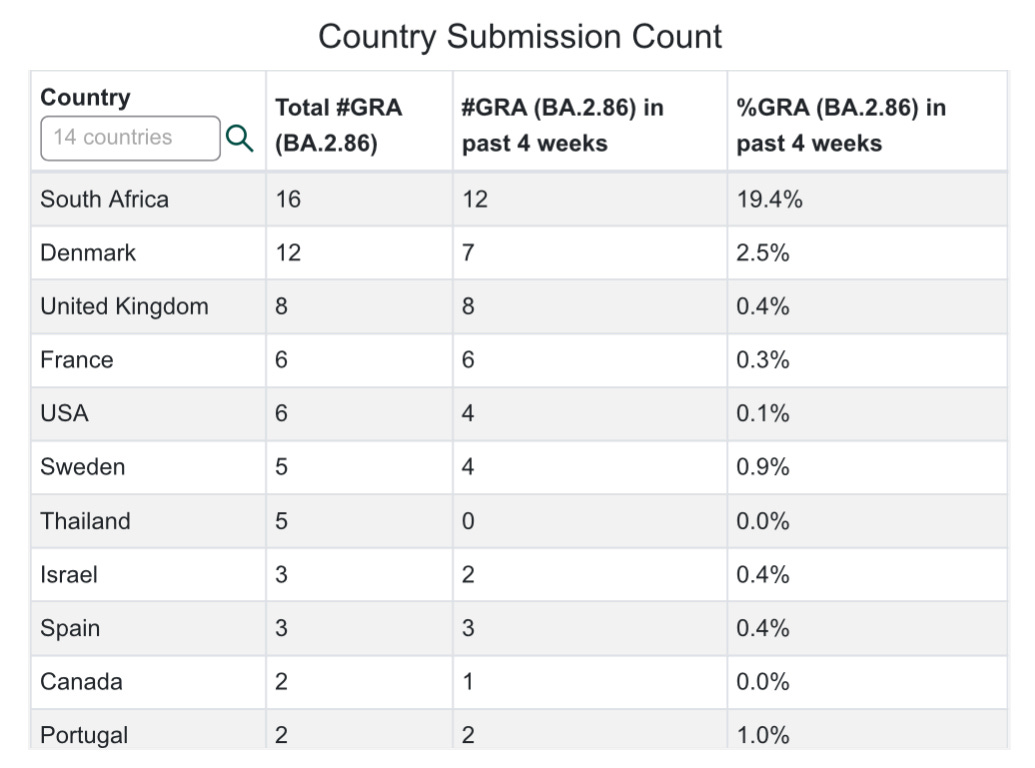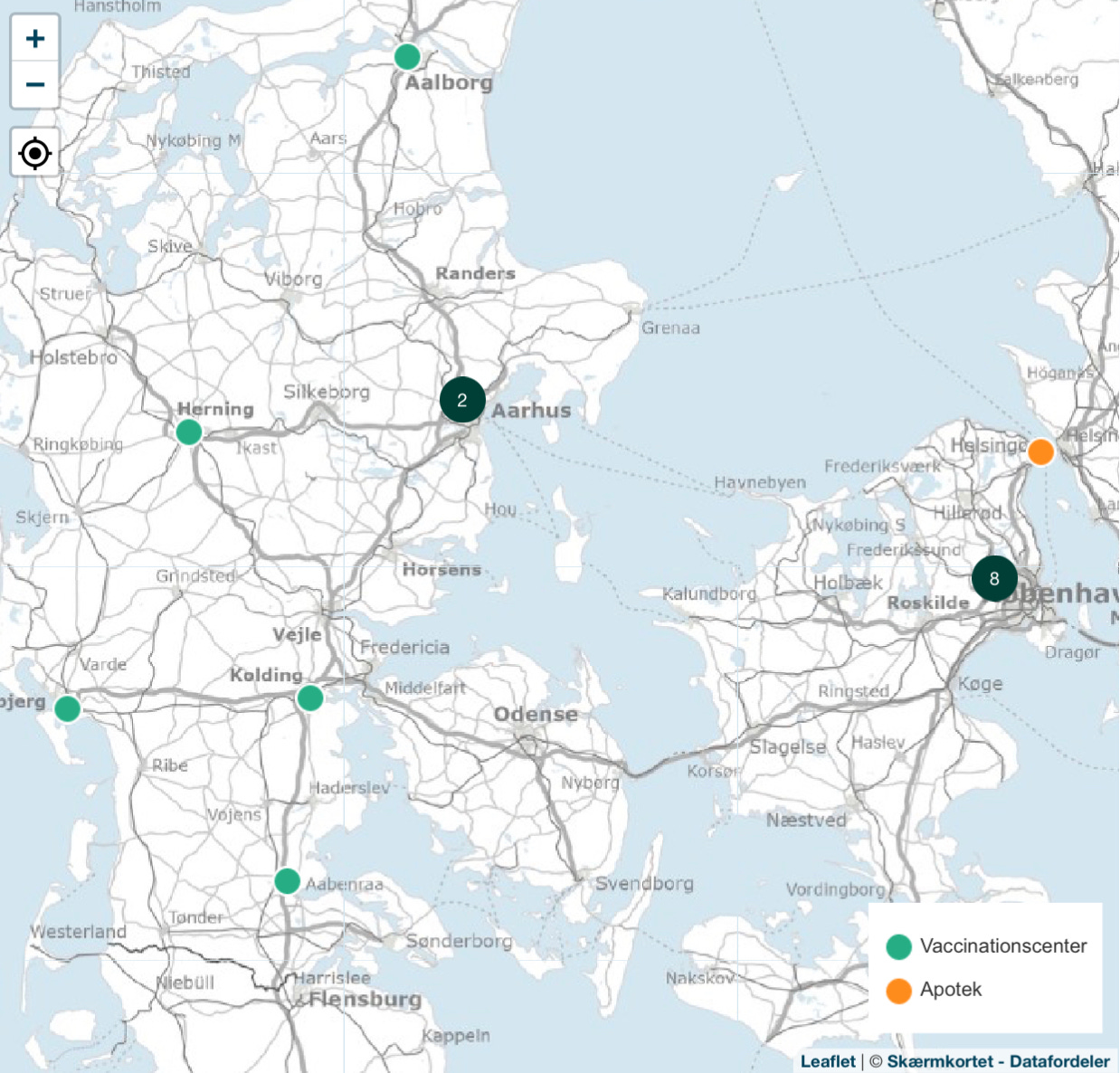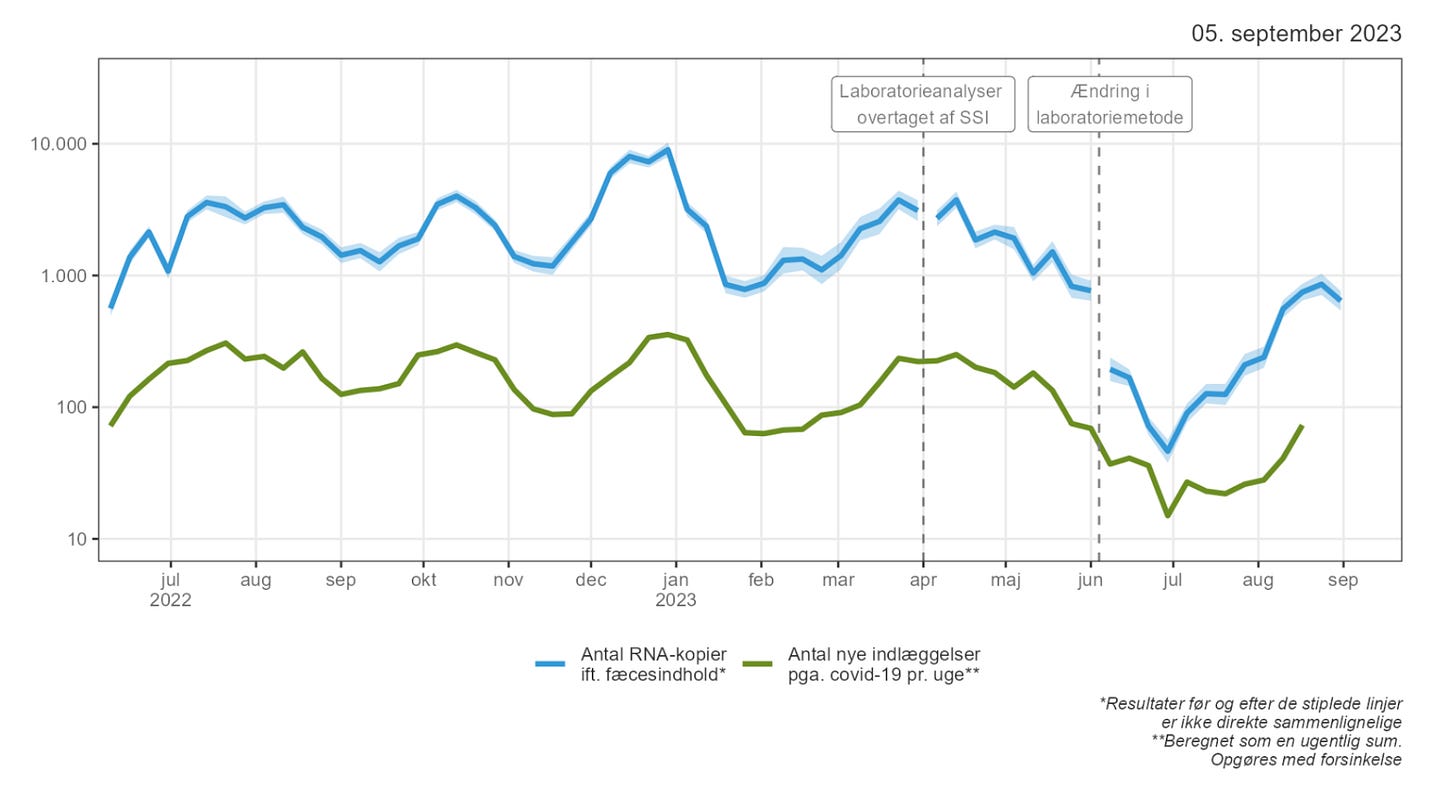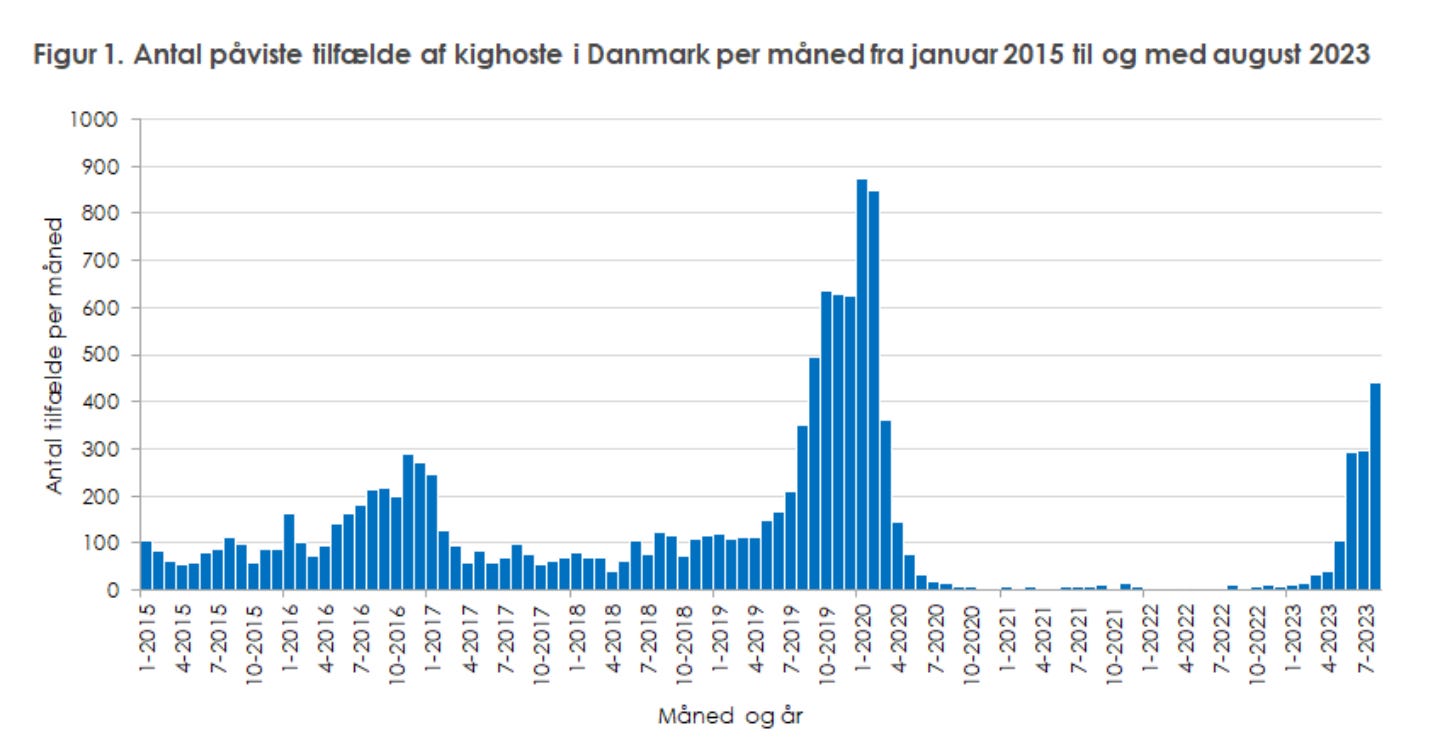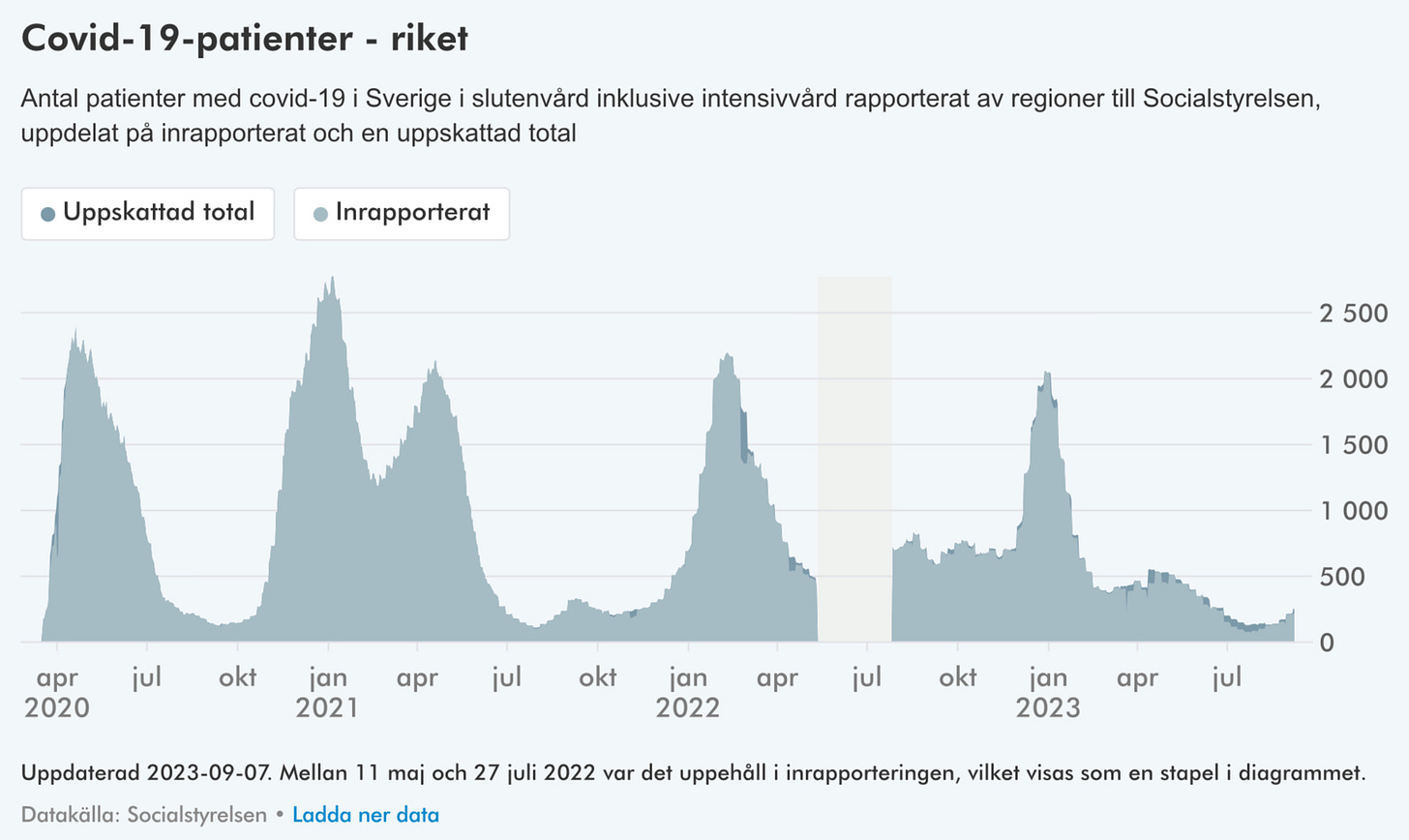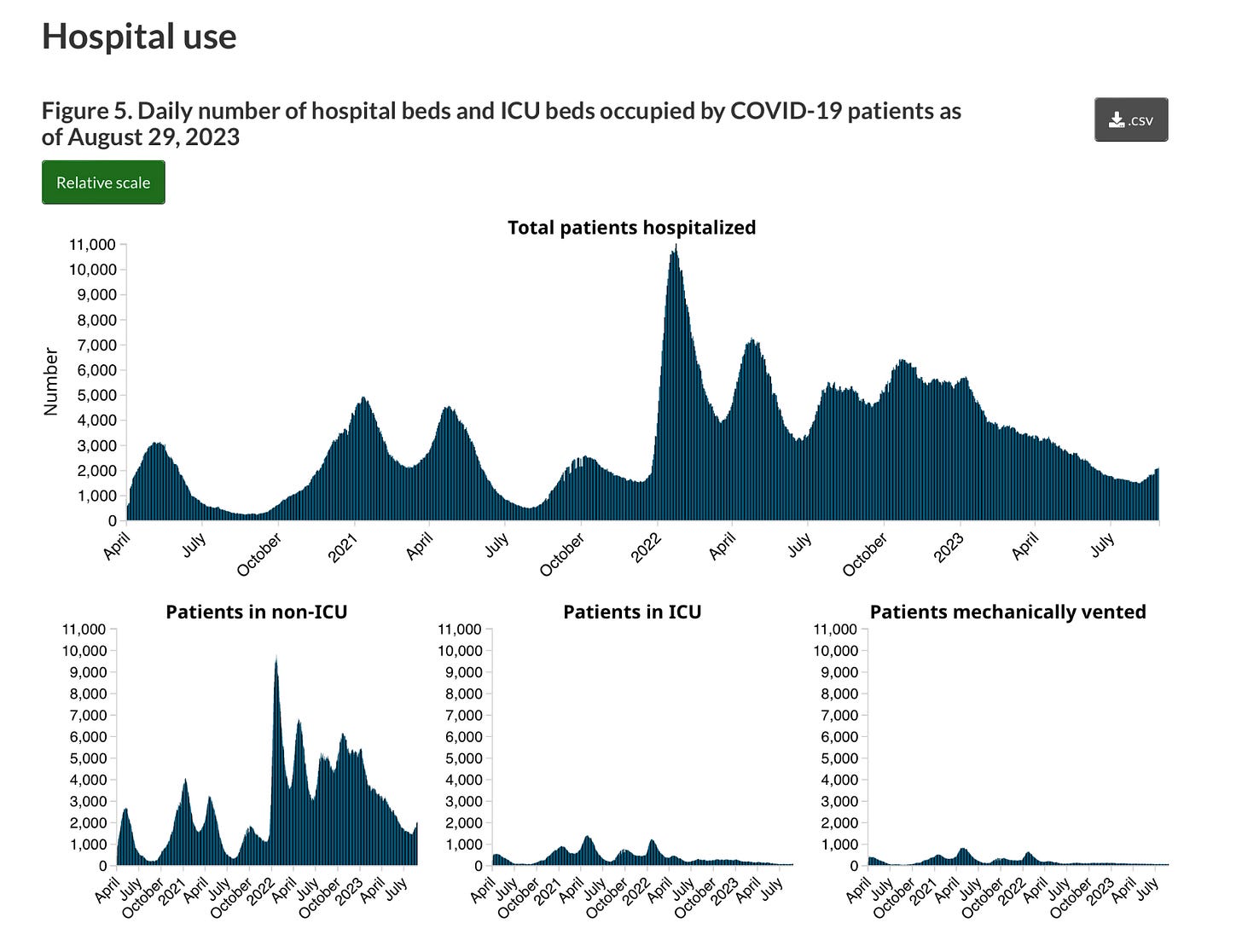The Evening Report - Sept 7
Climate change chaos in Europe. Whooping cough cases soar in Denmark.
🍃Environment & Energy⚡️
🇪🇺
The summer of 2023 has been the hottest ever recorded in Europe. That is according to the European Union’s Copernicus Climate Change Service. In June, July, and August this year the average temperature was 16.77 degrees. That is 0.66 degrees above the previous average.
Each month of the summer set a new global heat record one after another. The two hottest months ever recorded are now July and August 2023, which Copernicus says were 1.5 degrees warmer than any year going back to the pre-industrial era (1850-1900).
Copernicus Director Carlo Buontempo:
“Eight months into 2023, so far we are experiencing the second warmest year to date, only fractionally cooler than 2016, and August was estimated to be around 1.5°C warmer than pre-industrial levels. What we are observing, not only are new extremes but the persistence of these record-breaking conditions, and the impacts these have on both people and planet, are a clear consequence of the warming of the climate system.”
Antarctic sea ice extent remained at a record low level for this time of year. The amount of sea ice usually seen at this time of year was a whopping 12% below average “by far the largest negative anomaly for August since satellite observations began in the late 1970s.”
🇪🇺 🌧️ ☀️
An omega-block weather event is happening over Europe and it is causing spiking temperatures in some areas and unheard-of levels of rain in others. An Omega block describes what is essentially a traffic jam of multiple low and high pressures systems.
While unprecedented rainfall washes across a swath of Europe, other areas of the continent from the United Kingdom to Scandinavian countries are seeing nothing but sunshine and unusually high temperatures.
🇬🇷
Greece is the epicenter of the severe weather as it transitions from having Europe’s largest-ever wildfire to suddenly being deluged with record-breaking rainfall. Parts of Greece have seen over three feet of rainfall this week. In Zagora on the Aegean coast, 21 inches of rain fell in a matter of hours causing historic flooding.
🇪🇸
In Spain, weather went from searing temperatures to record-breaking rainfall from one week to the next. Heavy rainfall also triggered massive flooding across the country that has claimed several lives.
🇩🇰
Prepare to pay more for electricity in Denmark. Energinet, the Danish national electricity transmission company, says electricity use tariffs will increase in 2024 by 1.3 øre. The company says this means that on average a family in a detached home will see an increase of 232 kroner (about $45 Cdn) on their electricity bill. If the house has a heat pump and the family uses an electric vehicle then on average it could push the electricity bill up by 336 kroner (about $66 Cdn). Those projected increases do not include VAT.
Department Head Marie Budtz Pedersen says bills are going up due to the rising costs of operating and expanding the electricity network.
“The overarching factor is that the system must be adjusted so that electricity from wind and solar replaces oil, coal and natural gas. All of this requires large investments in new electricity grids in these years. And therefore it is necessary to raise the tariffs for the next few years.”
-
Could electric airplanes serve domestic routes across Denmark? That is the goal of Væridion, a German company that will be testing their electric airplane out on routes serviced by Copenhagen Air Taxi and Copenhagen Helicopter. The three companies have signed a cooperation agreement this week to accelerate the green transition of regional aviation. They are working to introduce the first 100% electric flights by 2030, at the latest.
Væridion CEO and co-founder Ivor van Dartel:
“We believe that the Nordic region will become the first in the world to implement this new form of air transport, made possible by the launch of our 100% electric Microliner aircraft. And with Copenhagen Air Taxi and Copenhagen Helicopter, we have found the ideal partners to promote our transportation concept in the Nordic countries, starting in Denmark.”
The company’s plane can carry nine passengers at a time, and it is expected to be able to fly routes of up to 500 kilometers. Its battery can be charged in 45 minutes.
-
DSB, the Danish National Railway Service, says it has reduced its CO2 emissions by 15,000 tonnes last year. That equates to 8% of the rail company’s total emissions. Since 2019 the rail company has reduced its emissions by 22%. DSB is working towards the goal of becoming carbon-neutral in all of its rail travels by 2030. Further, by 2050, it wants its entire value chain to be net-zero.
The rail company says when people choose to travel by train they make an environmental difference. It says for each traveler who chooses to travel by rail instead of car they emit four times less carbon. For example. DSB says traveling by train between Aarhus and Copenhagen saves 22 kg of CO2 emissions per passenger.
DSB is working to reduce its climate impact by buying more modern electric trains and transitioning to renewable energy sources to heat all of its stations, workshops, and other centers. It is also including climate impacts when putting tenders out for new trains, which places environment responsibility up the supply chain.
-
The Danish municipality of Furesø north of Copenhagen is one of the first in Denmark to fall in line with a legal mandate to set up a solar panel company to install solar panels on the roofs of public buildings. The Danish government leveled the mandate as part of its push for Denmark to reach carbon emission reductions by 2030. Some municipalities had pushed back on the law citing the cost of staffing and paying taxes to set up a solar panel company.
Furesø Mayor Ole Bondo Christensen told DR that they had to bite the bullet and get it done.
“It is difficult, but we have to do it. It is an important step towards becoming CO2-neutral in 2030.”
🇫🇮
Despite surging electricity prices last week, Fingrid, Finland’s national electricity grid operator, announced on Thursday that the risks of any electricity shortage this coming winter are low. The utility says the situation is much improved from what it was last year thanks to increased domestic electricity production and availability of power from its Nordic neighbours.
-
The green transition has been compared to winning the lottery in Finland. In an economic forecast, Nordea Bank said that abandoning fossil fuels will make the Finnish economy “shockproof” from fluctuations in world markets.
Nordea Economist Juho Kostiainen told Finnish newspaper Helsingin Sanomat that the green transition will strengthen the Finnish economy in both the short and long term.
Finland’s green transition has relied heavily on a major and rapid build-up of offshore wind farms, which helped the country achieve electrical self-sufficiency this summer for the first time in almost 20 years. But Finland is also building hydrogen production plants, battery material factories, energy storage facilities, and solar farms.
🇸🇪
As Sweden struggles with inflation the government announced on Thursday that it will reduce taxes on gas and diesel. As of January 1, 2024, gas taxes will be reduced by 1.64 Swedish kroner (about 20 cents Cdn).
Swedish Energy and Business Minister Ebba Busch made the announcement at a press conference on Thursday,
“We know that many families are having a hard time at the moment. Inflation has hit hard across the country.”
Sweden has been struggling with inflation driving up costs including, among other things, food prices.
🇫🇷 🇩🇪
France is going to take a look at the German model of placing a very cheap cost on all regional trains. In Germany, regional trains, metro, and busses can be used with a €49 monthly subscription service. Last summer Germany also issued one million €10 tickets on some national routes. The idea is to get people out of their cars and onto the transit system to help reduce CO2 emissions.
In an interview on the YouTube channel, HugoDecrypte, French President Emmanuel Macron was asked if he was in favour of a similar system in France.
“I have asked the Minister of Transport to launch it in all the regions that are willing to introduce the system.”
French Transportation Minister Clément Beaune followed that up with a post to his Twitter account.
“Let's introduce this train card in France for the sake of the environment and purchasing power in cooperation between the state and the regions.”
🦠COVID🦠
🌍 🦠 💉
It is looking more and more like we may have dodged something of a bullet with the new and much more mutated BA.2.86 variant. Further, studies of the strain’s genome indicate that it may not be as infectious as initially feared. Further both Moderna and Pfizer/BioNTech have reported separately that their own data seems to show updated vaccines targeting XBB variants also produce a strong antibody response against BA.2.86.
Pfizer/BioNTech said its data was from initial trials in mice while Moderna reported results from human trials. Moderna said its XBB-specific bivalent vaccine produced an 8.7 to 11-fold increase in neutralizing antibodies against currently circulating variants including BA.2.86, EG.5, and FL.1.5.1 strains.
Moderna President Stephen Hoge:
“These results demonstrate that our updated COVID vaccine generates a strong human immune response against the highly mutated BA.2.86 variant. Taken together with our previously communicated results showing a similarly effective response against EG.5 and FL.1.5.1 variants, these data confirm that our updated COVID vaccine will continue to be an important tool for protection as we head into the fall vaccination season.”
The updated Pfizer/BioNTech vaccine has been approved for use in Europe while Moderna’s bivalent candidate is awaiting regulatory approval.
-
Confirmed BA.2.86 variant infections continue to pop up around the globe with cases now confirmed in 14 countries according to the international genome database GISAID.
🇩🇰
The Danish National Board of Health says it expects to see COVID and influenza infections flare up again this fall and winter. It is finally announcing the details of this fall’s campaign to offer another round of COVID vaccine booster doses alongside influenza vaccinations. Vaccinations will begin on October 1. As was the case last year both COVID vaccine boosters and flu shots will be administered together.
Those eligible for both a COVID booster dose and an influenza vaccination:
Seniors over 65
People under 65 who are at high risk.
High risk populations include those suffering from:
Chronic lung diseases
Cardiovascular diseases
Diabetes 1 and 2
Immunodeficiency including those whose immune systems are suppressed due to things like cancer treatments or organ transplants
Respiratory issues
Chronic liver or kidney disease
Severely overweight
And other chronic illnesses making them vulnerable to severe infections
Pregnant women in the 2nd and 3rd trimesters are also eligible as are people who are in the same household with anyone who meets the above criteria.
The biggest change is the age group eligible for another booster dose. Last year, Danish health authorities allowed anyone in a high-risk population and everyone over the age of 50 to get boosted. This year it will only be vulnerable populations and seniors over 65.
Chief Physician Kirstine Moll Harboe explains the rationale for changing the age criteria for a COVID booster dose.
“Both influenza and COVID can affect anyone, and in the vast majority of people, these infections cause a mild course of the disease. In the elderly and certain other risk groups, however, both infections can be serious and, in the worst case, life-threatening. Therefore, the National Board of Health recommends that the elderly and risk groups be vaccinated against both influenza and coronavirus.”
For influenza vaccinations, a pediatric nasal spray will be available for children two to six years old. High-risk populations and seniors over 65 will also be eligible for the regular flu shot.
Chief Physician Kirstine Moll Harboe says the pediatric nasal vaccine is safe and very effective.
“When children are vaccinated, they are protected against four different types of flu virus and the child is at less risk of getting flu this season. The vaccination also reduces the risk of siblings, grandparents, or other people who are at increased risk of becoming seriously ill from influenza becoming infected. The influenza vaccine for children is a very effective and safe vaccine, and unlike many other vaccines, is given as a nasal spray with a puff in each nostril.”
Inoculations will be administered at sites across the country along with select pharmacies. For example in Region Midtjylland vaccine centers will be available in Aarhus, Horsens, Herning, Struer, Ringkøbing, Randers, Grenå, Skrive, Silkeborg, and Viborg.
This year, it is also possible to be vaccinated at select pharmacies around the country.
As usual in Denmark, vaccination invitations will begin to arrive via e-boks digital mail beginning in mid-September. Once an invitation is received then an appointment can be booked to get vaccinated.
The only exception is those under the age of 65 who won’t receive an e-boks invitation and instead must make their own appointments via www.vacciner.dk.
COVID vaccine booster doses and influenza vaccinations will be available until January 15.
-
Notably absent from the places where you can get a COVID or influenza vaccination this fall are the offices of family doctors in Denmark. Health experts on the Danish island of Bornholm are already raising the alarm over the National Health Board leaving doctors out of the mix.
Chair of Bornholm General Practitioners Helle Ahlmann Madsen says without family doctors helping with the vaccination effort a lot of vulnerable seniors and other high-risk populations on the island will be left in the lurch.
Speaking to DR she said:
“We have no earthly chance of vaccinating everyone.”
Madsen says family doctors are part of the community and work with the weak and vulnerable putting them in the best position to help and ensure they get vaccinated. There are three vaccination sites on Bornholm but she says many vulnerable island citizens will not be able to get to them.
-
COVID activity seems to be stabilizing across Denmark, or at least that is what wastewater surveillance seems to indicate. The Statens Serum Institute says there was a “slightly lower concentration” of coronavirus activity last week based on wastewater testing. If true, this would mark a slowing down of what has been a strong increase in virus activity over the previous nine weeks.
However, COVID hospitalizations (the green line) continue to rise in Denmark.
-
Denmark is experiencing a whooping cough epidemic. The Statens Serum Institute says cases across the country have been increasing rapidly over the summer. There were 439 confirmed whooping cough infections in August. That is four times higher than the usual number of cases in the month.
Department of Infection Epidemiology and Prevention Dr. Peter Henrik Andersen:
“This is a significant increase. It is well known that whooping cough occurs in epidemics three to five years apart, and the last time we had an epidemic was in 2019/2020. Typically, such an epidemic lasts for approximately half a year to a full year.”
While whooping cough infections occur across all ages it is usually children, especially infants, that are the most vulnerable.
The SSI has taken the step of reintroducing the whooping cough vaccine (pertussis vaccine) for pregnant women. The institute recommends women in the 2nd and 3rd trimesters get vaccinated. This ensures the baby has immune protection until around three months old when they can then get their own vaccination.
🇸🇪
COVID hospitalizations (216) crept upward in Sweden (+4) while the number of intensive care patients (5) remained static.
-
With its COVID vaccine booster dose campaign set to begin next month, the Swedish Public Health Agency is revealing who is eligible for another shot. The agency says vulnerable seniors over 65 and all others in high-risk populations can get another booster dose.
Deputy Unit Head Johanna Rubin:
“It is these groups that run the greatest risk of suffering severe infection as a result of COVID, and the Public Health Agency's assessment is that they need to top up their protection. People under 65, who have previously been vaccinated and who do not belong to any risk group, do not have the same risk and are therefore not covered by the recommendation.”
That said, the public health agency does add that for those under 65 who aren’t among a high-risk group, there may be individual reasons to get boosted.
“For these people, the vaccine will therefore be available.”
Sweden will first begin administering booster doses for vulnerable seniors in care in mid-October. All other eligible groups will get their chance to get boosted beginning in November. Flu shots will also be given at the same time for those eligible for both.
Department Head Johan Kaarme says they are timing the vaccination campaign a little later this year to ensure maximum protection when it is needed most.
“By getting vaccinated close to the season, you get better protection that lasts throughout the period when the spread of infection is expected to be at its highest. If you take your dose in connection with the regions' joint vaccination effort against influenza and COVID, we also expect that you will receive the updated variant-specific vaccine.”
🇫🇮
Finland will begin keeping a closer eye on farmed animals due to avian flu concerns. The Finnish Food Authority plans to begin regular monitoring of places like mink and poultry farms this month and keep up regular checks into the new year. Usually in Finland, such monitoring of such farms is only done for animal protection purposes and usually due to an outbreak or suspicion of one.
A number of mink farms in the country suffered avian flu outbreaks last month resulting in the culling of tens of thousands of animals.
The food authority will first do a comprehensive examination of the country’s 400 or so poultry and mink farms. Then it will launch stand-alone epidemiological checks.
Last week, the first case of avian flu in wild animals was confirmed in Finland.
🇺🇸
The U.S. Food and Drug Administration could approve newly formulated COVID variant-specific vaccine candidates from Moderna and Pfizer/BioNTech possibly by tomorrow (Friday).
-
The First Lady will not be accompanying President Joe Biden when he attends the G20 meetings in India, which start today. Jill Biden tested positive for a COVID infection earlier this week and has had to quarantine. She is 72 years old and her symptoms are described as mild. The President underwent follow-up testing before departing to India.
🇨🇦
COVID hospitalizations continue to climb across Canada. In the week ending August 29, the total number of hospital beds in use across the country by an infection case increased by 289 to 2,125. Most of those were General admissions, which rose by 288 week to week. Intensive care patients inched upward to 61 beds in use, an increase of one. While the number of really severely infected people requiring a ventilator also rose by four to 57.
The National seven-day positivity percentage also continues its upward march and is now 13.4%.
-
In Ontario, Ottawa Hospital says that beginning on September 11, masking will be required in all clinical areas and waiting rooms.
🇺🇦/ 🇷🇺 War
🇩🇰 🇺🇦
The transfer of F-16 fighter jets from Denmark to Ukraine may have hit a speed bump. Danish Defense Minister Troels Lund Poulsen announced on Thursday that Lockheed Martin has delayed the delivery of new F-35 jets that were expected to arrive early next year. Delivery has now been pushed back to the last half of 2024 “at the earliest.”
“Today I was informed that the delivery of the next Danish F-35 fighter jets will be delayed. This of course annoys me a lot.”
Lockheed Martin is blaming software issues for the delay. Denmark has seven of the new jets already although all seven are at an American Air Force base in Arizona. That is where Danish pilots are being trained on the more advanced aircraft. The first of the next-generation aircraft aren’t due to arrive on Danish soil until sometime next month.
Denmark recently announced it will donate some of its aging F-16 fighter jets to Ukraine. The fleet of Danish F-16s were supposed to begin being decommissioned last year but were kept on active duty due to the war in Ukraine and the eroding security situation in Europe. Until the new F-35 jets are phased in it isn’t likely Denmark will hand over any F-16s currently in use.
🇩🇰/ 🇷🇺
The Russian Embassy in Copenhagen has announced it will stop providing most consular services. It blames the move on the Danish Ministry of Foreign Affairs for limiting the number of embassy employees. Due to what it claims is understaffing the embassy will no longer receive or process consular applications and documents. The embassy does say it will work to continue to assist Russians living in Denmark.
Denmark’s Foreign Affairs Ministry recently placed a cap on employees at the Russian embassy. Effective no later than September 29, it can only employ five diplomats and a further 20 employees.
🇩🇰 🇺🇦
Danish Prime Minister Mette Frederiksen was in Ukraine this week. She arrived Wednesday morning on Kyiv in her third visit to the country since Russia’s invasion in February of last year. Frederiksen addressed the Ukrainian parliament.
“At this moment, Ukrainian fighter pilots and other personnel are being trained in Denmark. Trained to fly F-16 fighter jets. I have met some of these men and women in Denmark. I can promise you, they are proud, confident, and eager to bring F-16s home to Ukraine. You are moving closer to the EU and NATO. I am really deeply impressed, and Denmark will support you all the way.”
While in Ukraine, Frederiksen also met with US Secretary of State Antony Blinken who was also visiting the country. One of the big topics between the two was reportedly the status of the F-16 training program and ongoing support for Ukraine.
🇫🇮 🇺🇦/ 🇷🇺
Finnish President Sauli Niinistö told journalists on Thursday that there is no end in sight to the war in Ukraine. The President was meeting with the Finnish Association of Political Journalists where he took questions from reporters in attendance. Niinistö said Russia has dug in deep defensive positions over areas of occupied Ukraine and it will be a tough challenge for Ukrainian troops to drive them out.
Soberingly, he also told reporters that the risk of nuclear escalation and the possibility of nuclear weapons being used has to be taken seriously. Niinistö said should it happen, adding there is no indication it will, that it would mean the end of the world.
🇷🇴 🇺🇦/ 🇷🇺
Romania continues to raise the alarm after a Russian attack last weekend on a Ukrainian port caused explosions just 800 meters from the Romania border. There were reports that a Russian drone had landed in Romania and exploded but the country’s President, Klaus Iohannis, is denying that ever happened.
“There was no wreckage and no drones or any parts of any other device reached Romania. But yes, we are concerned because these attacks are taking place at a very short distance from the Romanian border.”
Russia has begun focusing its aerial bombardment on Ukrainian ports in the Danube delta after withdrawing from an international deal to get shipments of grain from Ukraine to other countries abroad.
🇬🇧/ 🇷🇺
The British government is close to declaring the Russian pseudo-private militia group, Wagner, a terrorist organization according to the BBC. If it follows through it would then be illegal to be a Wagner member, support the group financially, and its assets could be seized.
However, they could be a little late to the party. Since Wagner leader Yevgeny Prigozhin died or rather was very likely assassinated when a plane he and other Wagner leaders were on crashed the Russian government has been working at dismantling the organization and absorbing it into the Ministry of Defense.
🇸🇪
Cyber security in Sweden is not up to snuff leaving the country exposed to cyberattacks. That is according to several cyber security experts in the country. Head of Cybersecurity at the Swedish Civil Contingencies Agency Åke Holmgren told Radio Sweden that the public and private sectors need to work better together to address a shortfall of skilled cyber workers.
“Those of us in the public sector cannot sit back and think we are good enough. We are not.”
🏊♀️ 🇷🇺 🇧🇾
In a move that will almost certainly draw criticism the World Aquatics, the international federation governing water sports, has opened the door to athletes from Russia and Belarus. Since Russia’s illegal invasion of Ukraine athletes from Russia and Belarus have been banned from competing across a host of sports. World Aquatics has decided that athletes from the two Soviet countries can compete but only under a neutral flag. They will also be forbidden to express support for the war in Ukraine or sport any symbols, flags, or other National emblems. The Russian and Belarusian national anthems will also be banned should athletes from either country win an event. The governing body has also capped the number of athletes in any aquatic event to one from each of the two countries. Any Russian or Belarusian athletes will also face increased supervision from anti-doping authorities.




